
Mercedes-Benz EQB review

Introduction
Mercedes-Benz has quite a large number of vehicles in its range nowadays. And, in case you’re looking at the title of this article and thinking, "what the heck's an EQB?" then you're evidently unfamiliar with Merc's new electric vehicle nomenclature.
To be honest, so are we. ‘EQ’ is simply the name of Mercedes’ electric range, so you’d imagine that the EQS, for example, is the electric S-Class. But the EQS isn’t a like-for-like comparison. Likewise, the EQB is nothing like a B-Class.
In fact, the EQB is an all-electric version of the GLB. And, if that still means nothing to you, let’s cut to the chase: it’s a seven-seat SUV. And all-electric seven-seaters are a pretty rare thing – for the moment, at least – with only Tesla offering an alternative in the form of a Model X and Model Y.
Select's rating score* - 3.6 / 5
At a Glance
Compared with the GLB, there are a few subtle changes at the front. For example, there's a blanked-out grille and blanked-out air vents towards the sides, while the traditional widened ‘n’-shape, which surrounds the lower grille, has been flattened.
The sides are barely distinguishable from the sister car, with a smooth shape to the doors and only a modest crease running along the bottom to break up the design. Meanwhile, the overhang of the rear spoiler above the window extends down the sides, too, which gives the car a boxy shape at the back.
The rear is the one thing that does look markedly different. Unlike the GLB, there’s a horizontal strip of LEDs running along the entire width of the boot. In addition, the displaced Mercedes badge has been moved down a bit, meaning the number plate has had to be transferred to the bottom. This transforms the rear – but arguably makes a more striking impression than its fossil-fuelled sibling.

Key Features
Of course, the main feature of the EQB is that you're swapping the petrol (or, indeed, diesel) forecourt for electric charging points, and this seismic change is enough to put some people off.
But, as we’ll see, there are lots of reasons not to be daunted by it.
There are two variants to choose from – both of which have two electric motors and four-wheel drive.
The EQB 300 4MATIC has a 168kW dual-motor producing 228PS, getting from 0-62mph in 7.7-seconds.
The more powerful EQB 350 4MATIC, on the other hand, has a 215kW dual-motor, which produces 292PS, getting you from a standing start to 62mph in 6.0-seconds.
This is a way off Tesla performance but, then, in a seven-seater 4x4, do you really need to be up to 62mph in less time?
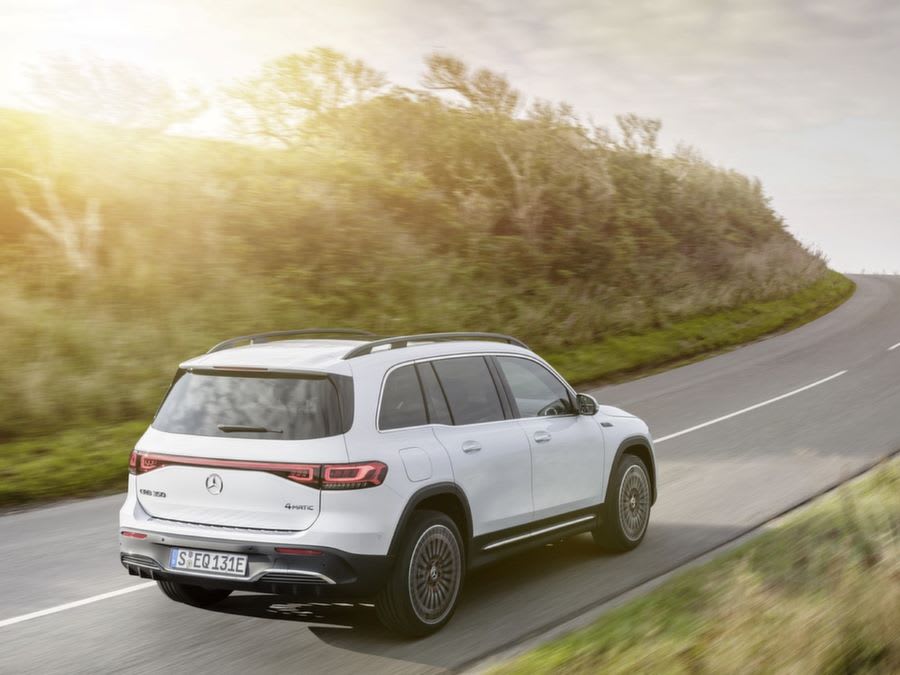
There are two trims to choose from – AMG Line and AMG Line Premium.
Entry-level AMG Line gets you 18-inch alloy wheels, comfort suspension, cruise control, automatic high-beam and LED headlights. You also get heated electric door mirrors, a reversing camera, rain-sensing wipers, 64-colour ambient interior lighting and illuminated door sills.
On top of that, you get a sports steering wheel, aluminium pedals, heated electric front sports seats with four-way lumbar support, auto climate control and a DAB radio.
Phew! If that's not enough, there's also a 10-inch MBUX infotainment system with Apple CarPlay and Android Auto, a three-year live traffic information subscription and a 10-inch digital instrumental display.
AMG Line Premium adds a little sprinkle on top, including 19-inch alloys, an electric panoramic glass sunroof, keyless go, an upgraded sound system and a wireless phone charger.

Range & Batteries
Both the EQB 300 and 350 versions come with a 66kWh battery. To help translate that to driving miles, consult our guide on what kWh and kW really mean.
Interestingly, despite one having 64PS more power than the other, both claim the same range, which is up to 257-miles.
Of course, expect less than this in the real world. Why? Well, temperature, driving style, and road conditions can all dramatically influence the actual range in practice.
But, if you’re driving long-distance and have ‘range anxiety’, don’t fret. Merc has got that covered, as we’ll explain later on. The EQB didn't quite make our top 10 longest range EVs of 2022, but it's cousin the EQS nabbed the top spot!

Performance & Drive
The first thing you notice is the super-responsive acceleration off the line. Of course, electric cars have bucket loads of torque, so bang-your-head-on-the-headrest levels of acceleration aren’t exactly anything to shout about. But it will catch you by surprise if this is your first time at the tiller of an electric vehicle.
Electric car fans might not be overwhelmed because, compared with a Tesla, the 0-62mph times aren't awe-inspiring. However, compared with most fossil-fuelled GLBs, they are much, much quicker.
While it's easier to notice wind and tyre noise in a car without an engine, the lack of under-car mechanics means the floor is flatter and, therefore, more aerodynamic. This helps to cut down on the noise that would be made by the rush of air hitting pipework in a petrol or diesel. As a result, it's slightly more aerodynamically efficient, too.
Another thing to consider is that you can fine-tune the car's setup in the infotainment system to your heart's content. So, for example, rather than just choosing the entire vehicle to be in "sports mode" (in fact, in the EQB, you get Max Range, Eco, Comfort and Sport), you can also independently tune various parts of the car, including the suspension.

So, you could, in theory, set the acceleration to 'sport' but leave everything else in comfort mode. This means you’ll be getting the best of both worlds in terms of performance without sacrificing the ride, which is very comfortable. We'd advise this, as setting the throttle response to any other mode seems to restrain the acceleration.
As with most electric cars, the batteries add quite a lot of extra weight (around 250-350kg in fact) and, as a result, the EQB has stiffer suspension – but it’s adaptive, which cancels out any lost ride comfort.
At low speed, it’s very relaxed, quiet, easy to drive and is perfectly capable around town. On longer distances, the Benz isn’t taxing at all and, if you do need to do a lot of motorway miles, you’ll still be arriving feeling on the fresh side. What’s more, it handles high-speed roads effortlessly.
To conserve battery power, the 4MATIC four-wheel-drive system only activates when needed. This means that most of the time, the EQB is rear-wheel drive only, but you can feel the increased traction at the front when the four-wheel-drive system kicks in.
Despite the AMG badging, you couldn't call this car overly sporty. It’s too heavy and tall to be athletic. Nevertheless, when going around a corner, the steering is light, and there are tonnes of grip on turn-in. That said, the EQB does tend to understeer slightly mid-bend as the weight really gets thrown to the side.

A moderate amount of body roll is inevitable, but it's not excessive, as long as you don’t try to push it too hard. This isn’t a low-to-the-ground hot hatch, after all, so you’re best off not trying to drive it like a Golf GTi.
You should also note that the all-electric Benz comes with paddle-shifters behind the steering wheel. Rather than changing gear (there aren't any gears), these paddles adjust the amount of regenerative braking – or 'recuperation', as Mercedes-Benz calls it.
There are five regenerative braking modes: D-Auto, D-plus (coasting), D (low recuperation), D-minus (medium recuperation) and D-minus-minus (high recuperation). What this means in practice is that D Auto will manage the amount of regenerative braking by itself. D-plus will apply no regenerative braking, allowing the car to simply coast when you don’t have the foot on the accelerator, while D, D-minus and D-minus-minus are for minimum, medium and maximum recuperation.
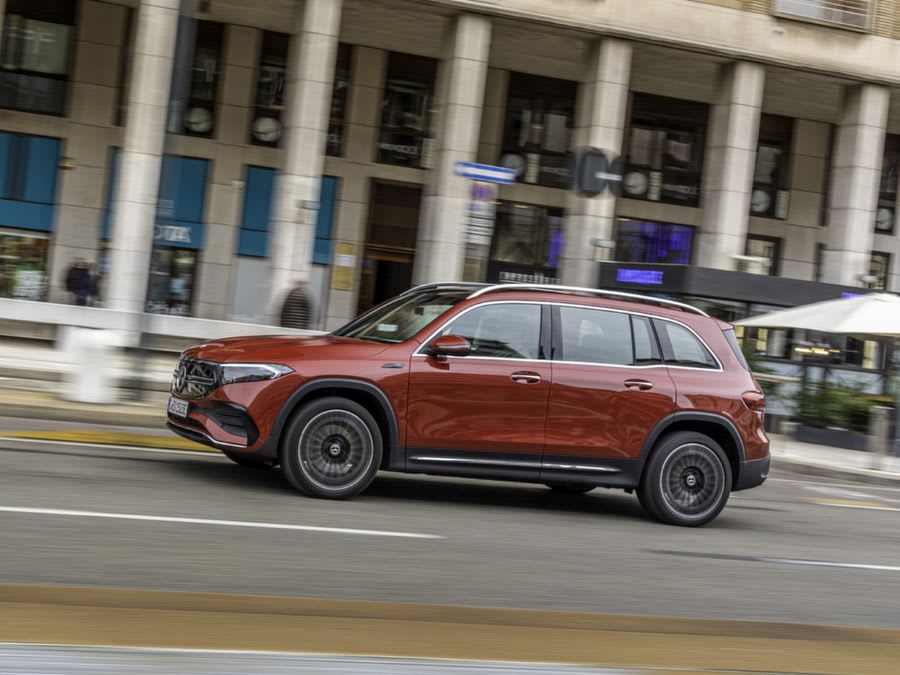
Regenerative braking, in simple terms, 'grabs' energy that would otherwise be lost under deceleration, converting it into an electrical charge that it can put back into the battery, maximising the vehicle's range.
In some cars, when it’s turned up fully, this effectively enables one-pedal driving as, once you remove your size-11 from the accelerator pedal, the regenerative braking slows the car for you, coming to a complete stop. The EQB doesn’t quite do this – it does slow the car to a very slow crawl, but it leaves you to apply the final touch on the brakes to stop.
We recommend leaving it in D-Auto mode, though. Why? Well, it utilises the car's SatNav system, which assesses your driving, the road and traffic conditions to optimise the regenerative braking and the battery levels accordingly. It may mean that, in some situations, you need to take command over the use of the brake pedal, though.
Charging
A home 7kW wall charger will take 11-hours to get from empty to a full charge. To make sure you're getting the right home charging point, we've compiled a guide on how to pick your idea electric car charger.
However, juice it up at a public charger where there’s 100kW-charging available, and you'll be able to go from 10-80 per cent in a little more than half an hour. This is ideal for charging for long range travel, or even if you justcan't charge at home.
Although this is technically called 'rapid' charging, this isn’t particularly quick, as some electric vehicles are capable of being charged at 300kW (though few public charging points can provide this yet).
All models of the EQB come with charging cables and connectors as standard.

Running Costs & Emissions
Of course, there are no emissions on the EQB to worry about. And if you've got solar panels, you can charge for even less.
No emissions mean no road tax, either. And that’ll put the EQB firmly into the eye line of company car drivers who are keen to take advantage of the benefit-in-kind tax savings as a result.
In terms of running costs, though, this is a Mercedes-Benz, so don't expect maintenance to come particularly cheaply.
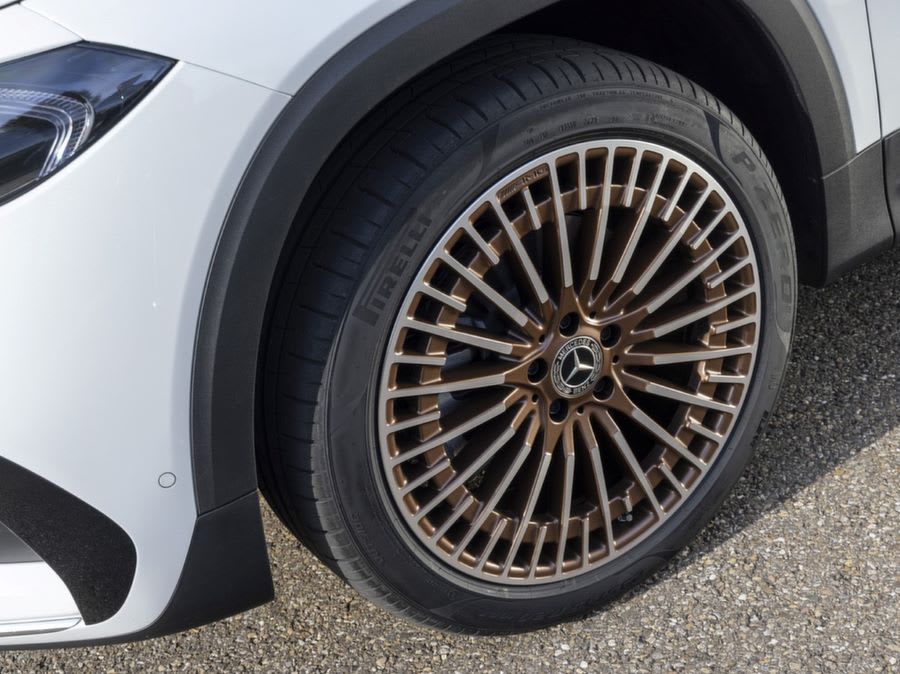
Interior & Technology
The interior is very similar to the GLB– but that’s no bad thing. Merc interiors are very nice anyway.
The two 10-inch screens – the digital instrument display and the infotainment screen – sit next to each other to effectively act as one very long screen.
Both are crisp, clear and attractive, with the infotainment screen offering you charging options, consumption data and energy flow information. The infotainment system as a whole is responsive, user-friendly, and, without doubt, one of the nicest to operate.
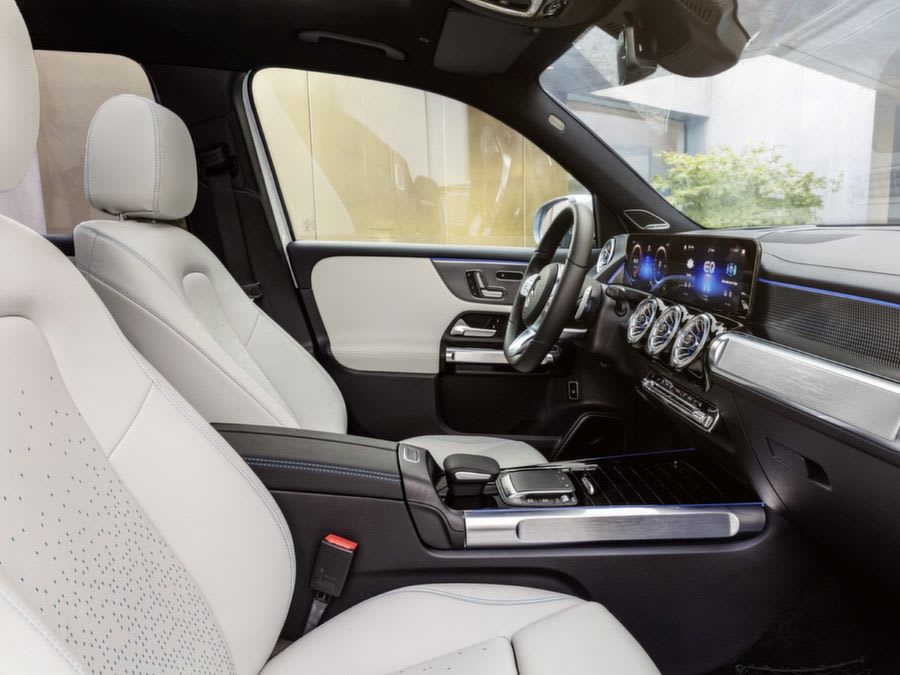
Earlier, we mentioned range anxiety. But, if you're making a journey that you haven't got enough range for and plan your route using the SatNav, it will automatically factor in charging stops, adding them to your route. Therefore, there’s no need to be watching the ‘rangeometre’ ticking down all the time.
Additionally, it’s customary on battery-powered Mercedes cars that modest amounts of light blue symbolise electricity. Therefore, the stitching on the seats and centre console, the air vent surrounds, and even the outer edges of the floor mats are just some of the places you can expect to find this accented touch.
Furthermore, defrosting on a cold winter’s morning can be taken care of thanks to an app on your phone, which can pre-heat the cabin before you get in.

Practicality & Boot Space
There's lots of space in the front to stretch out and feel relaxed. The visibility is excellent, too, thanks to a large windscreen, a commanding high driving position, and sizeable door mirrors. Also, because of the EQB’s boxy shape and lack of a sloping roof, you get an excellent view out of the back.
The backs of the front seats are curved, too, which maximises knee-room for the row behind. There's a lot of space in the middle row in any case, while headroom is a non-issue. Admittedly, because the floor is slightly raised to accommodate the batteries, taller passengers may find they have somewhat less support for their thighs, as their knees will be slightly raised. Still, you should be able to adjust yourself to suit, given how roomy it is.
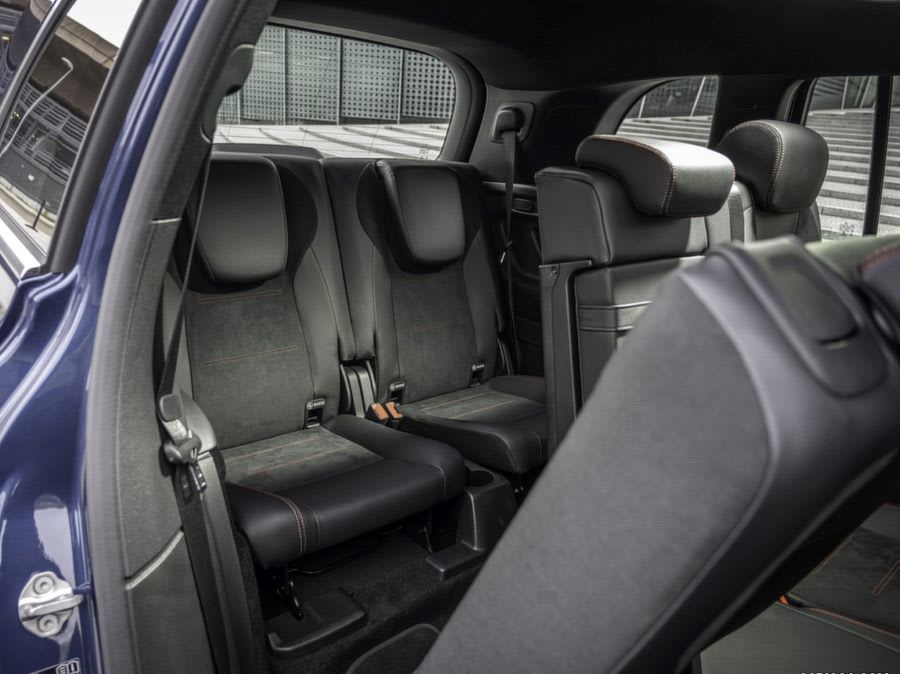
The two back seats to make it a seven-seater are optional but, if you have them, your rear passengers might be a bit jealous of those in front. Only two seats there means there’s a decent amount of room side-to-side – and the headroom isn't compromised much – but there's not a massive amount of legroom. That said, unless you have a large family, it's unlikely they're going to be used all that much.
There's a lot of storage space, with big door bins and a decent centre console, while in the boot, you’ll get 465-litres of cargo capacity (495-litres in the five-seater version). This compares to 500-litres (seven-seater) and 500-litres (five-seater) in the GLB.
Disappointingly, there's no storage space under the bonnet and, if you're planning on towing trailers or caravans, note that the towing capacity is reduced to 1.8-tonnes (the GLB can tow up to 2.0-tonnes).

Safety
Euro NCAP tested the EQB back in 2019, and it earned a five-star rating, scoring an impressive 95 per cent for adult occupants, 91 per cent for children and 74 per cent for safety assists.
You get active brake assist, active lane-keeping assist, active speed limit assist, an emergency call system and Urban Guard vehicle protection, all as standard. The latter monitors and tracks the car's status and location, amongst other things.
However, adaptive cruise control isn't standard, which is very surprising. Although there are many drivers who’ve never experienced it before, this technology has been around for a while now. It is hardly a novelty anymore – plus it’s now included as standard on lots of far lesser brands. For Mercedes-Benz to demand extra for it is very disappointing, especially as the EQB is more expensive than the GLB on which it’s based.
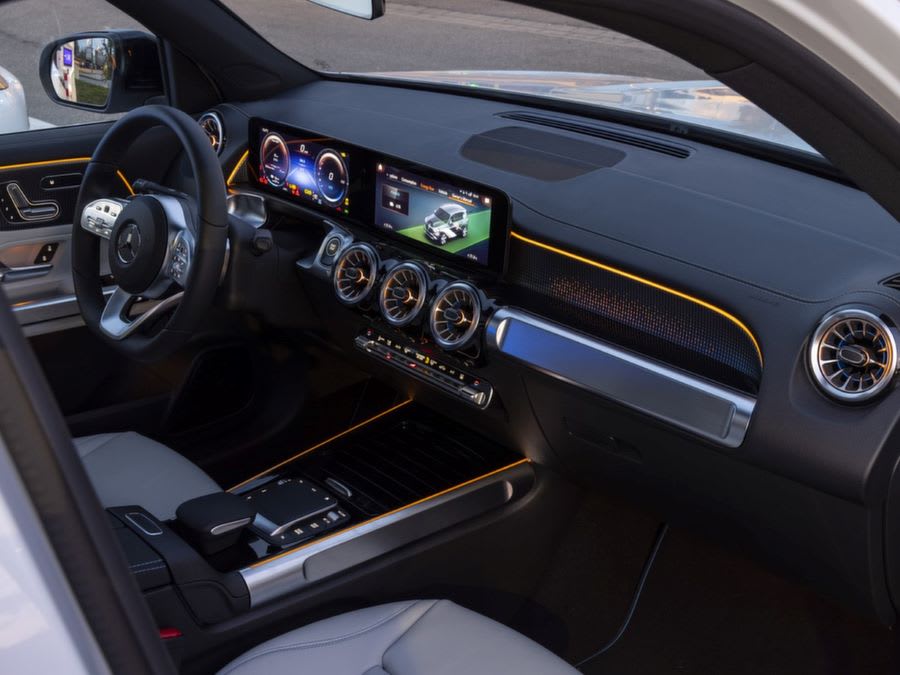
Options
Black or white solid paint is provided as standard. But if you want any other shade, it's an extra cost option, which seems rather excessive.
Disappointingly, although a vegan-friendly interior is offered, the steering wheel remains leather. Most bizarre.
And, despite it being a posh car, the EQB – a vehicle built for long-distance journeys – doesn't come with adaptive cruise control as standard. Instead, it's part of the Driving Assistance Pack, which costs a fair packet.
Mercedes-Benz needs to do better than this. For example, you get adaptive cruise control as standard on a Toyota Corolla.

Rival Cars
There are very few all-electric seven-seaters available at the moment.
Tesla’s Model X and Model Y are the only other two. Therefore, you’ll be looking towards hybrids as alternatives, such as the BMW X5 or the Land Rover Discovery Sport - the latter of which is still a couple of years off from being all-electric.

Verdict & Next Steps
Overall, the Mercedes-Benz EQB is a desirable proposition. It has good acceleration and boasts a lovely interior with amazing gadgetry and a great infotainment system. Plus, it’s exceptionally practical.
But Teslas are much quicker, while they and other rivals remain more fun to drive. And although the EQB is cheaper than a Tesla, it's also a lot more expensive than its fossil-fuelled sibling, the GLB.
Furthermore, making you pay extra for adaptive cruise control should, for a premium brand, be very ‘last decade’ by now.
Nevertheless, minor faults aside, this is a decent effort from Mercedes-Benz that, for the moment at least, has very few competitors.
Where to next?
View latest Mercedes-Benz EQB Leasing Deals- from just £621.02 per month inc VAT**
Looking for a great leasing deal? Check out our incredible range of Special Offers
New SUV? Read our latest Car Reviews and find the right model for you
Want to know more about leasing? Take a look at our comprehensive Leasing Guides
Interested in everything motoring? Why not catch up on all the latest Car Leasing News.
**Score based on Select’s unique meta score analysis, taking into account the UK’s top five leading independent car website reviews of the Mercedes-Benz EQB
**Correct as of 28/04/2022. Based on 9 months initial payment, 5,000 miles over a 48 month lease. Initial payment equivalent to 9 monthly payments or £5,589.18 Ts and Cs apply. Credit is subject to status.






















